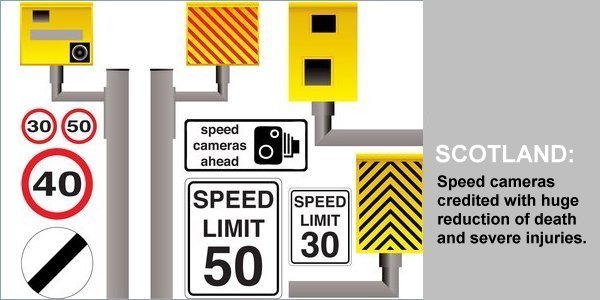|
|
 |
 |
 |
 |
Scottish Speed Cams Claimed To Reduce Accidents By Over 60
Article by: rob brady
Date: 1 Aug 2012

According to latest figures, the number of severe injuries and fatalities in Scotland has dropped by almost two thirds following the introduction of fixed speed cameras.
The number of fatalities and injuries were monitored across 166 sites before and after the introduction of speed cameras, with the average number of incidents falling from 92 to 36 during this period.
Total injury numbers were reported to have also fell significantly, reaching a low of 684. This represents a reduction of more than 50% from before the installation of speed cameras when total injury counts reached 1,400.
Yet, despite these promising figures, attitudes towards speed cameras remain mixed. The number of drivers caught speeding through the sites is claimed to have increased and the 2011 Key Scottish Safety Camera Programme Statistics report revealed more than half of respondents felt the number of speed cameras is excessive.
Commenting on the findings, Road Safety Officer for the RoSPA (Royal Society for the Prevention of Accidents) Kathleen Braidwood condemned the rising number of speeding motorists as "disappointing".
Meanwhile, a spokeswoman for the Scottish Government celebrated the reduction in injuries before emphasising their attitude to improving road safety by announcing "one death on our roads is still one too many".
Similar reductions in serious injuries and road deaths were noted on mobile speed camera sites in the country and come despite revelations from last year that less than one third of Scottish speed cameras are operational.
Source
| | |  |
| Comments
|
 Posted by rf065 on Wed Aug 01, 2012 3:44 pm Posted by rf065 on Wed Aug 01, 2012 3:44 pm |
 |
I think the fact that most of Scotland's drivers no longer use their car for leisure purposes due to the cost of fuel is more likely to account for the drop in accidents.
Most of the folk I know put £20 or £30's worth of fuel in every week for getting to work and back only. The rest of the time the car is parked up.
Still, never let the truth get in the way of a bit of propaganda for the "safety camera" brigade.
Russ
|
|
 Posted by wetsleet on Wed Aug 01, 2012 8:19 pm Posted by wetsleet on Wed Aug 01, 2012 8:19 pm |
 |
regression to the mean is the typical explanation for results like these. You can try it out at home. You need several dice, one each to represent a putatitive speed camera site, and a felt tip pen
1) roll each dice in turn and record any sixes thrown
2) let a six equal an accident/fatality at the site
3) after several rounds, pick the sites with most accidents
4) using the felt tip pen, draw a speed camera at those sites
5) continue rolling the dice
6) notice that the camera sites now exhibit a more normal number of sixes
|
|
 Posted by MaFt on Wed Aug 01, 2012 9:16 pm Posted by MaFt on Wed Aug 01, 2012 9:16 pm |
 |
| wetsleet Wrote: | regression to the mean is the typical explanation for results like these. You can try it out at home. You need several dice, one each to represent a putatitive speed camera site, and a felt tip pen
1) roll each dice in turn and record any sixes thrown
2) let a six equal an accident/fatality at the site
3) after several rounds, pick the sites with most accidents
4) using the felt tip pen, draw a speed camera at those sites
5) continue rolling the dice
6) notice that the camera sites now exhibit a more normal number of sixes |
That has to be the best explanation of 'regression to the mean' that I've ever seen!
MaFt
|
|
 Posted by M8TJT on Thu Aug 02, 2012 6:45 am Posted by M8TJT on Thu Aug 02, 2012 6:45 am |
 |
Super explanation. The main problem is that RtM does not fit comfortably with the Safety Camera Partnership method of calculating their statistics. It seems to be generally totally ignored when referring to accident reduction.
|
|
|
|
 |
|
|
 |
 |
 |
 |
|
|